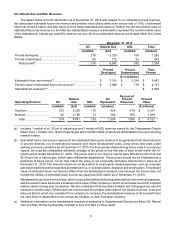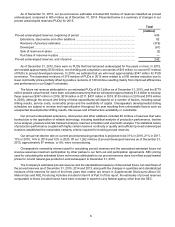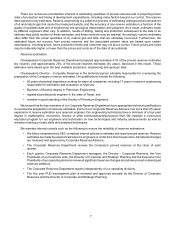Chesapeake Energy 2015 Annual Report Download - page 19
Download and view the complete annual report
Please find page 19 of the 2015 Chesapeake Energy annual report below. You can navigate through the pages in the report by either clicking on the pages listed below, or by using the keyword search tool below to find specific information within the annual report.15
response actions to reduce the risk of future contamination. Federal laws, including the Comprehensive Environmental
Response, Compensation, and Liability Act (CERCLA) and analogous state laws impose joint and several liability,
without regard to fault or legality of the original conduct, on classes of persons who are considered legally responsible
for releases of a hazardous substance into the environment. These persons include the owner or operator of the site
where the release occurred, persons who disposed of or arranged for the disposal of hazardous substances at the
site, and any person who accepted hazardous substances for transportation to the site. CERCLA and analogous state
laws also authorize the EPA, state environmental agencies and, in some cases, third parties to take action to prevent
or respond to threats to human health or the environment and/or seek recovery of the costs of such actions from
responsible classes of persons.
The Underground Injection Control (UIC) Program authorized by the Safe Drinking Water Act prohibits any
underground injection unless authorized by a permit. Chesapeake recycles and reuses some produced water and we
also dispose of produced water in Class II UIC wells, which are designed and permitted to place the water into deep
geologic formations, isolated from fresh water sources. Permits for Class II UIC wells may be issued by the EPA or by
a state regulatory agency if EPA has delegated its UIC Program authority. Because some states have become concerned
that the disposal of produced water could under certain circumstances contribute to seismicity, they have adopted or
are considering adopting additional regulations governing such disposal.
Air Emissions
Our operations are subject to the federal Clean Air Act (CAA) and comparable state laws and regulations. Among
other things, these laws and regulations regulate emissions of air pollutants from various industrial sources, including
our compressor stations, and impose various control, monitoring and reporting requirements. Permits and related
compliance obligations under the CAA, each state's development and promulgation of regulatory programs to comport
with federal requirements, as well as changes to state implementation plans for controlling air emissions in regional
non-attainment or near-non-attainment areas, may require oil and gas exploration and production operators to incur
future capital expenditures in connection with the addition or modification of existing air emission control equipment
and strategies.
In 2012, the EPA published final New Source Performance Standards (NSPS) and National Emissions Standards
for Hazardous Air Pollutants (NESHAP) that amended the existing NSPS and NESHAP standards for oil and gas
facilities and created new NSPS standards for oil and gas production, transmission and distribution facilities with a
compliance deadline of January 1, 2015. In 2013 and 2014, the EPA issued updated rules regarding storage tanks
and made additional clarifications to these rules. In December 2014, the EPA issued additional amendments to these
rules that, among other things, distinguish between multiple flowback stages during completion of hydraulically fractured
wells and clarify that storage tanks permanently removed from service are not affected by any requirements. In July
2015, the EPA finalized two updates to the rules addressing the definition of low pressure gas wells and references to
tanks that are connected to one another (referred to as connected in parallel). Further, in September 2015, the EPA
issued a proposed rule that would update and expand the NSPS by setting additional emissions limits for volatile
organic compounds and regulating methane emissions for new and modified sources in the oil and gas industry. In
January 2016, the BLM also proposed rules to require additional efforts by producers to reduce venting, flaring, and
leaking of natural gas produced on federal and Indian lands.
In 2010, the EPA published rules that require monitoring and reporting of greenhouse gas emissions from petroleum
and natural gas systems. We, along with other industry groups, filed suit challenging certain provisions of the rules
and are engaged in settlement negotiations to amend and correct the rules. We anticipate final resolution to this litigation
in the near future. In October 2015, EPA finalized new reporting requirements for boosting systems, completions and
workovers of oil wells using hydraulic fracturing, and blowdowns of natural gas transmission pipelines. In January
2016, the EPA proposed two more revisions to the greenhouse gas reporting rule. One proposal addresses leaks from
oil and gas equipment and the other proposal is intended to improve implementation of the rule, while also proposing
confidentiality determinations for the reporting of certain data elements to the program.
In addition, in October 2015, the EPA published its final rule revising downward the ozone national ambient air
quality standard to 70 parts per billion. Our business and operations could be subject to increased operating and
compliance costs associated with these regulations.
























